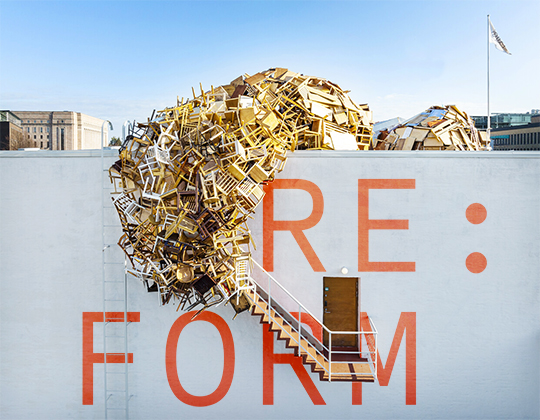Studio E/01
Re:Form
Nancy Ji
Studio Description
Re-forming the Anthropocene: A Centre for Regenerative Building
Architects today need to respond to the ecological crisis and think beyond growth-oriented narratives to seek out new strategies that reduce resource consumption. By examining architecture’s material culture, Re:form studio focuses on reusing and repairing what already exists: how can we rework existing buildings, components, and material resources towards a post-carbon future? As miners of the Anthropocene (the human-made geological layer surrounding planet Earth), architects must learn to use existing resources and consider the end-of-life potential of the buildings they design. Re:form studio students will research the relationship between architecture and wider socio-ecological systems through the design of a Creative Maker Space that serves as a model for regenerative design and construction. This new hybrid building type will have several key functions including a material “bank” for bio-based and salvaged materials and flexible spaces for experimentation and education for the wider community.
Studio Outcomes
Re:form studio challenges students to consider the potential social and ecological impacts and regenerative opportunities of the entire building life cycle. Starting with research-driven design, students are asked to analyse and diagram their chosen existing resource/building materials that they wish to salvage, repurpose, and prepare for reuse in their Creative Maker Space. Students will then choose a site with a preference for working with existing building stock and consider the de-construction potential of their projects. At the end of the studio, students should be able to understand and apply circular economy principles and have a deeper knowledge of material ecologies including alternative low-carbon and bio-based building materials. Re:form studio encourages students to experiment with model-making, prototypes, and experimental forms of graphic representation.
Studio Leaders
Nancy Ji is an architect, researcher, and Lecturer in Architectural Design at The University of Melbourne. Since 2015, she has taught at the Melbourne School of Design in Architectural History, Theory and both undergraduate and graduate Design Studios. After working in Melbourne at Bates Smart Architects, Nancy moved to Japan to pursue doctoral studies at Keio University, Japan, where she conducted fieldwork examining contemporary renovation and repair culture in the adaptive reuse of vacant buildings.
Readings & References
Baker-Brown, D, The Re-Use Atlas: a designer’s guide towards a circular economy, RIBA Publishing, London, 2017
Charter, M, (Ed), Designing for the Circular Economy, Routledge, Oxford, 2018, inc. chapter 31by Baker-Brown, D, Who is mining the Anthropocene?
Gorgolewski, M, Resource Salvation: The Architecture of Reuse. Wiley Blackwell, Toronto, 2017, inc. The Waste House: a case study
Lewis, P, & Tsumaki, M & Lewis, D, Manual of Biogenic House Sections. Oro Editions, 2022
Kuittinen, M, Organschi, A & Ruff, A, Carbon: A Field Manual for Building Designers, John Wiley and Sons, 2022, inc, chapter 4 “Decarbonized Design” and chapter 5 “Re-forming the Anthropocene”
Material Cultures & D, Amica, Material Reform, Mack Books, 2022
Stahel, W R, The Circular Economy; a user’s guide, Routledge, 2019, London & New York
The Re-entanglement Charter https://www.bauhauserde.org/initiatives/re-entanglement
Exhibition: The Great Repair https://archplus.net/en/archiv/english-publication/The-Great-Repair/
Schedule:
Thursday 12:00pm-6:15pm in MSD 139
Off-Site Activities:
